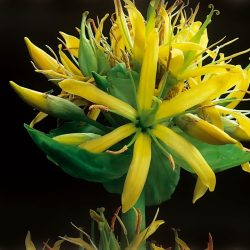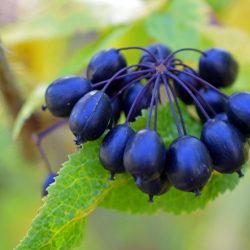Bearberry is one of the great omissions from medical literature throughout antiquity. The Middle Ages fared little better, considering that the earliest documents relating to it date back only to the 12th century: some English books mention its use, and it is even mentioned in a 13th-century Welsh herbarium entitled Les médecins de Myddfai (The Doctors of Myddfai). In France, it was Rabelais (a doctor and writer) who first highlighted the diuretic effects of bearberry in his literary work Gargantua, describing Pantagruel suffering from a urinary infection.
What is bearberry?
Bearberry, or Arctostaphylos uva-ursi, is a small shrub in the Ericaceae family, native to the United States and widespread in mountainous regions in the northern hemisphere. In France, it is mainly found in the southern hemisphere and in mountainous areas. Appearing from May to July, small pink bell-shaped flowers accompany its spatula-shaped evergreen leaves. These flowers form clusters and produce red drupes, hence the nickname “bear’s grape“.
Bearberry’s drug is its leaves. They are mainly composed of arbutin (or arbutoside), a substance with therapeutic effects. The leaves are harvested in summer and dried for medicinal use. Bearberry is known for its use in the treatment of moderate urinary tract and bladder disorders. However, there is not yet sufficient clinical evidence to support this use.
The plant is a creeping sub-shrub, often forming cushion-like clumps. Its thin bark exfoliates easily. It is considered to be a ground-covering coloniser. Its simple, alternate, thick, leathery leaves have a shiny, oval-oblong blade.
Bearberry flowers are radially symmetrical and pentamerous, with a five-toothed calyx and a pink or pinkish-white ureate corolla. It has ten stamens and a multi-ovulated supere ovary.
The fruit are bright red drupes when ripe, containing five single-seeded nucules. These berries are eaten by bears and are decorative, but mealy and tasteless. The arbutoside in the leaves is a phenolic heteroside, absorbed in the intestine and hydrolysed into β-D-Glucopyranose and hydroquinone, which has an antiseptic action on the kidneys. More than half of the arbutoside ingested is eliminated in the form of glucuronide and hydroquinone sulphate. Bearberry also contains gall tannins and flavonoids.
A little history
In the 20th century, Botan reaffirmed the plant’s diuretic and antiseptic powers. He wrote that “this dual property is put to good use whenever it is necessary to cure inflammations accompanied by purulence”. Leclerc, who was well aware of what his predecessors had observed about bearberry, made the following observation: the leaves of the pear tree act in the same way as those of bearberry. This is what he said: “their infusion behaves like a good diuretic, capable of exerting on the urine an antiputrid action similar to that ofuva-ursi: it is therefore used in cystitis, bacteriuria and urinary lithiasis; under its influence, the volume of the urine increases, the excreted liquid becomes clearer and thus loses its fetidity and the painful phenomena of which the bladder is the seat are sedated”.
Charles de Barbeyrac (1629-1699) also recommended bearberry “to soothe nephritic pain and remove mucus and sand from the urine”. But it wasn’t until the Viennese doctor Dehaen – who undoubtedly best appreciated the therapeutic value of bearberry – that this plant was recommended for “all those with prolonged and abundant suppuration, resistant to other therapeutic means, in the urinary system, kidneys, ureter, bladder, urethra, scrotum and perineum, without any venereal traces and without obvious signs of a calculus”, he wrote in his Ratio medendi in nosocomio practico in 1758.
Following the establishment of these medicinal properties, many practitioners followed in Dehaen ‘s footsteps to test this plant, said to be the best remedy for suppurations of the urinary tract.
What are the main pharmacological properties of Bearberry leaves?
In vitro, the free hydroquinone in Bearberry has an effective antibacterial action on bacteria such as Escherichia Coli, Proteus Vulgaris, Staphylococcus aureus and Enterococcus Vulgaris.Antibacterial efficacy depends on the bioavailability of hydroquinone and its conjugated form. In the past, it was recommended that urine should be alkalinised to promote hydrolysis of complexed hydroquinone into free hydroquinone. However, recent studies by Garcia De Arriba have revealed that it is the bacteria themselves that release the free form. In fact, in an environment where coccobacilli were cultured with conjugated hydroquinone, it was observed that this was transformed into free hydroquinone in the intracellular medium of the bacteria.
Urinary antiseptic properties
These properties are linked to the activity ofarbutin, a powerful urinary disinfectant and anti-inflammatory active on Escherichia coli, the main germ responsible for urinary tract infections.Arbutin is only metabolised in the urinary tract, where it is hydrolysed into glucose and hydroquinone (a substance very similar to phenol), a powerful antiseptic. This transformation therefore takes place in alkaline or alkalinised urine.
Hydroquinone, phenolic acids and pikeoside act synergistically on a wide range of germs, including Escherichia coli, Staphylococcus aureus, Mycoplasma, Pseudomonas aer, Proteus vulg, Klebsiella pneumonia, Enterococcus faecal and Streptococcus. These active ingredients are also antimycotic(candida albicans) and virostatic.
In addition, the leaves are antimicrobial in vitro and in vivo against numerous germs(Candida, Staphylococcus, Escherichia, Salmonella).
Anti-inflammatory, analgesic, astringent and decongestant properties for the urinary tract
Bearberry’s therapeutic properties are partly due to the presence of iridoids and allantoin, which are healing and reconstituting agents for the epithelium of the urinary mucosa.
Bearberry’s aquaretic action, i.e. its ability to increase renal elimination of water, is attributed to the arbutoside, flavonoids and phenolic glucosides present in its leaves. In people suffering from fluid overload, bearberry promotes the elimination of sodium and potassium. Arbutoside, which is stable in the plant thanks to its tannins, is hydrolysed by the intestinal flora, releasing hydroquinone, a phenol which is then conjugated in the liver and excreted via the kidneys.
The plant also contains gall tannins, which have astringent properties. In high doses, these tannins can present a health risk. It also contains mucilage,arbutin and a glucoside that splits into hydroquinone and glucose under the action of certain ferments. In a basic environment, conducive to the development of bacteria responsible for cystitis, hydroquinone develops and destroys the germs, providing anti-infectious properties.
In association with heather or callune leaves, in the form of a decoction, bearberry leaves reinforce their antibacterial properties.
Bearberry leaves have an anti-inflammatory and antiseptic action on the urinary tract, and are used to prevent recurrent cystitis,prostate hypertrophy, urinary retention, urethritis, nephritis, urinary incontinence, diarrhoea, menorrhagia, leucorrhoea and other urinary or gynaecological disorders.
Are there any precautions to be taken when using Bearberry?
As hydroquinone requires alkaline urine to be produced and exert its antiseptic action, it is necessary when using bearberry to ensure that the urine pH is alkaline (measured by dipstick) or to alkalinise the urine by simultaneously adding sodium bicarbonate; either mineral waters such as St Yorre (4368 mg/L), Vichy Célestins (2989 mg/L) and Badoit (1300 mg/L), or sodium bicarbonate, or citrates (of sodium, potassium, magnesium), or via a diet rich in fruit and vegetables. It is advisable to drink plenty of water during treatment (at least two litres a day).
Contraindications:
- The EMA does not recommend bearberry for pregnant or breast-feeding women due to its oxytocic, uterostimulant and teratogenic properties.
- Bearberry is also contraindicated in cases of urinary tract cancer and kidney disease.
- According to the European agency, it is not recommended for children and adolescents for traditional use. Urinary tract infections in children and adolescents, even at an early stage, should be treated under medical supervision.
Precautions for use :
- Bearberry extracts are used in discontinuous cures of limited duration.
- The German Commission E recommends that bearberry should not be taken for more than one week or more than 5 times a year without medical advice.
- According to the EMA, the use of bearberry in men goes beyond its traditional use, which is recommended for women only.
- In the event of overdose, anorexia, nausea, vomiting, headache, irritability, insomnia, increased heart rate and albuminuria may occur.
Drug interactions :
- Bearberry may potentiate the gastrointestinal toxicity of synthetic non-steroidal anti-inflammatory drugs.
- Avoid taking substances that acidify the urine (medicines, vitamin C, cranberry, acidic fruit juices such as citrus fruit or prunes).
- Aqueous and methanolic extracts of 5 uva-ursi products showed strong inhibition of the cytochrome p450 isoenzyme.
How should Bearberry be taken and at what dosage?
Bearberry is a medicinal plant commonly used in phytotherapy for its antiseptic and diuretic properties. However, it’s important to know how to take bearberry and at what dosage to get the most out of it. In this section, we’ll look at the different ways to take bearberry and the recommended dosages for different types of condition.
Dry form :
- As a dietary supplement: in the form of dry extract or powder, in capsules.
- In the case of urinary tract infections, heather capsules can be taken in combination with this, at a rate of 1 capsule 3 times a day.
Liquid form :
- Standardised fluid extract of fresh plant: 5 to 10 ml per day in a glass of water, preferably in the morning.
- Herbal teas: 10 to 15 g of leaves per litre of water (after boiling, leave to simmer for 30 mins), 1 to 2 g per cup, to be drunk 3 to 4 times a day. To avoid gastric irritation due to the high tannin content, mint leaves can be added.
Bearberry as a magistral preparation of standardised extracts in liquid form (EPS)
Bearberry is a popular medicinal plant known for its antiseptic and diuretic properties. It is often used in phytotherapy to treat urinary tract infections and bladder disorders. In this section, we’ll explore the use of bearberry in the preparation of standardised extracts in liquid form (SPE) and how it can be used to improve your health and well-being.
Combination with Echinacea 1/3 to 2/3 Bearberry :
We recommend combining bearberry with echinacea in cases of cystitis with lowered immune defences in the acute phase or as a preventive treatment in an 8 to 10-day course (alternating with the cranberry/pilosella mixture).
Echinaceas, such as Echinacea purpurea, Echinacea angustifolia and Echinacea pallida, are renowned for their medicinal properties. They strengthen the immune system, fighting infection, and have anti-inflammatory effects, useful for joint problems. They also help heal wounds and have antioxidant properties that protect cells. These plants are traditionally used to treat Candida albicans infections. However, medical consultation is essential before using them.
Echinacea increases splenocyte proliferation, boosts natural killer (NK) cell activity and modifies T lymphocytes and cytokine levels. Compounds such as cichoric acid, echinacosides, alkylamides and polysaccharides stimulate the immune activity of white blood cells.
Echinacea has been used for centuries for its healing and anti-infectious properties on wounds. It is beneficial for treating skin infections (eczema, psoriasis, acne), respiratory ailments (colds, bronchitis, sinusitis, flu) and gastrointestinal infections. Its antibacterial action acts on Streptococcus pyogenes and methicillin-resistant Staphylococcus aureus. It also has virucidal and antifungal activity, notably against Candia albicans.
Echinacea’s dose-dependent anti-inflammatory action is due to its polysaccharide fraction and alkylamides. It inhibits phosphatidylinositol-3-kinase, cyclo-oxygenase, 5-lipoxygenase and hyaluronidase. It also modifies macrophage activation, inhibiting expression of inducible nitric oxide synthase (iNOS ) and increasing macrophage arginase activity. In addition to ENT and respiratory infections, it is effective in the treatment of recurrent minor aphthous ulcers and has an anti-inflammatory effect in models of rheumatoid arthritis.
Combination with pilosella 1/3 for 2/3 bearberry:
It is recommended to combine bearberry with pilosella in the treatment of early, painful cystitis or cystitis with haematuria. To prevent recurrent colibacillosis, clear urine cystitis or inflammation of the urinary tract.
Pilosella is a plant with varied pharmacological properties, including diuretic, hepatoprotective and anti-inflammatory effects. It has bacteriostatic properties, thanks to umbelliferone. Umbelliferone, a coumarin, is capable of inhibiting bacteria such as Brucella and Salmonella typhimurium, as well as Staphylococcus aureus and Escherichia coli. In addition, isotein 4′-O-β-D-glucopyranoside, a flavonoid extracted from the plant, inhibits the growth of Pseudomonas aeruginosa, an action reinforced by the presence of antibacterial phenolic acids.
In terms of its detoxifying and aquaretic properties, its flavonoids help to eliminate urea,uric acid and chlorides. Inulin may be the source of its diuretic action.Inulin , a fructan, increases osmotic pressure in the renal glomerulus, leading to greater elimination of water. It therefore relieves inflammation of the urinary tract.
Pilosella also helps to increase vasodilatation of the renal parenchyma, improving glomerular filtration rate. On the hepatodigestive level, the umbelliferone in pilosella has a choleretic effect, helping to regulate cholesterol levels. It also has a spasmolytic effect on the sphincter of Oddi, and its astringent tannins have an anti-diarrhoeal and intestinal healing action.
Pilosella’s polyphenolic compounds, such as chlorogenic acid,apigenin-7-O-glucoside and umbelliferone, have antioxidant, anti-inflammatory and cardioprotective properties.Antiproliferative activity against a colon carcinoma cell line has been confirmed for isoetin 4′-O-β-D-glucopyranoside. These polyphenolic compounds also show significant antimicrobial, antimutagenic and antioxidant effects.
Association with orthosiphon
Bearberry is recommended in combination with orthosiphon for the after-effects of renal colic, inflammation of the urinary tract.
Orthosiphon leaves have a wide range of pharmacological properties. With regard to its diuretic and antilithiasic properties, Orthosiphon increases diuresis, excretion of Na and Cl- ions, and elimination of uric acid, while conserving potassium. This action is attributable to its flavonoids, such as sinesetin and eupatorin, and its caffeic acid derivatives. The lithospermic acid derivatives it contains also help to reduce uraemia and increase glomerular filtration.
In terms of nephroprotective properties, the ursolic and oleanolic acids present in orthosiphon are capable of inhibiting the binding of TGF-β1 to its receptors, suggesting its potential efficacy in the treatment of kidney disease.
On the hepatobiliary level, orthosiphon stimulates hepatocytes and intensifies bile secretion, thus improving bile evacuation.
On a metabolic level, orthosiphon has hypoglycaemic properties, inhibiting α-glucosidase and α-amylase, which is beneficial in the management of type 2 diabetes. It also promotes fat mobilisation, helping to manage weight.
Finally, orthosiphon’s anti-inflammatory, antioxidant and anti-infectious properties are noteworthy. Its compounds, such as orthosiphols and diterpenes, reduce inflammation in a dose-dependent manner. The plant’s lipophilic flavonoids also offer antioxidant protection and demonstrate analgesic and anti-inflammatory activities. In addition, orthosiphon has anti-adhesive effects against Escherichia coli bacteria, helping to prevent colibacillary urinary tract infections.
Association with sweet clover
Bearberry and sweet clover are recommended for painful congestion of the pelvis and for healing the urinary mucosa following cystitis or pyelonephritis treated with antibiotics.
The flowering tops of sweet clover have a number of important pharmacological properties:
Clinical studies in the 1990s revealed the effect of coumarin derivatives of sweet clover in reducing lymphoedema. For example, a double-blind, placebo-controlled study demonstrated the efficacy of coumarin in reducing chronic unilateral filarial lymphoedema and elephantiasis of the legs.
Sweet clover also acts on the lymphatic, venous and capillary systems . It increases vessel tone and stimulates the lymphatic pump. This lymphokinetic action results in an increase in the frequency and strength of lymphatic contractions. There is also an improvement in lymphatic vascular activity.
M. Officinalis extracts have been shown to be effective in significantly reducing post-mastectomy lymphoedema. Studies on patients treated for 6 months have demonstrated this.
Sweet clover also helps to reduce capillary permeability. It therefore improves tissue oxygenation and microcirculation. It stabilises the erythrocyte membrane.
At the tissue trophic level, it stimulates revascularisation mechanisms. This promotes healing and tissue regeneration by stimulating the proteolytic power of macrophages and the reticuloendothelial system.
In terms of anti-inflammatory action, sweet clover has anti-oedematous properties, comparable to hydrocortisone hemisuccinate. The latter reduces the activation of circulating phagocytes.
Lastly, sweet clover has other properties such as a sedative, mild analgesic and spasmolytic effect. It also has mild anticoagulant, antineoplastic, anti-ischaemic and antiviral properties.
Medical bibliographical sources and clinical trials
- Durrafourd C., La Praz J.C., Cahier de phytothérapie clinique, Maloine, 1985
- Girre L., Connaître et reconnaître les plantes médicinales, Ouest-France, 1980
- European Medicines Agency, Assessment report on Arctostaphylos uva-uesi (L.) Spreng, folium, Final 2018
- Matsuda H. et al, Pharmacological studies on leaf of Arctostaphylos uva-ursi (L.) Spreng. V. Effect of water extract from Arctostaphylos uva-ursi (L.) Spreng (bearberry leaf) on the antiallergic and antiinflammatory activities of dexamethasone ointment, Yakugazu Zasshi, 1992
- Chauhan B. et al, In vitro activity of uva-ursi against cytochrome P450 isoenzumes and P-glycoprotein, Can J Physiol Pharmacol, 2007
- Guillerey P., ‘Contribution à l’étude des plantes médicinales à réputation diurétiques’, doctoral thesis in pharmacy (Diplôme d’Etat), Nancy I. 1982
- Arriba SG, Naser B, Nolte KU. Risk assessment of free hydroquinone derived from Arctostaphylos Uva-ursi folium herbal preparations. Int J Toxicol. 2013
- Chemical Information Review Document for Arbutin and Extracts from Arctostaphylos uva-ursi. Supporting Nomination for Toxicological Evaluation by the National Toxicology. 2006







